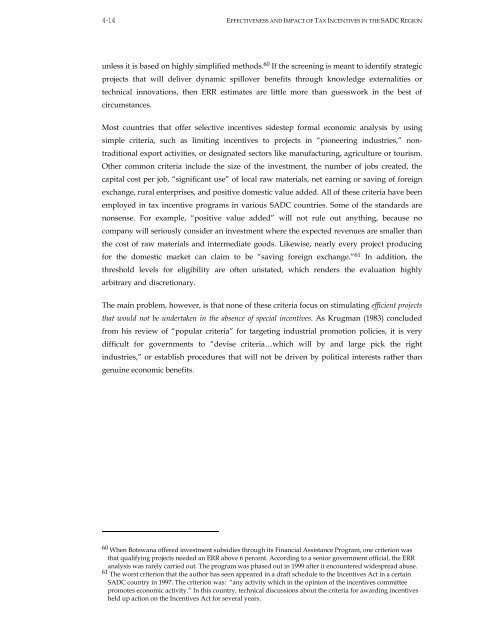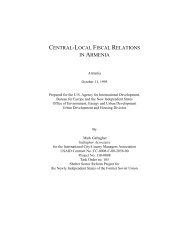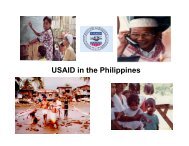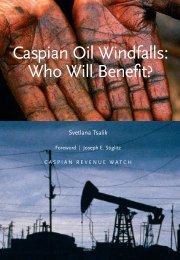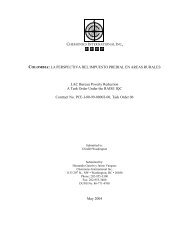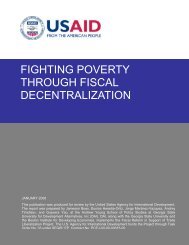Effectiveness and Economic Impact of Tax Incentives in the SADC ...
Effectiveness and Economic Impact of Tax Incentives in the SADC ...
Effectiveness and Economic Impact of Tax Incentives in the SADC ...
Create successful ePaper yourself
Turn your PDF publications into a flip-book with our unique Google optimized e-Paper software.
4-14 EFFECTIVENESS AND IMPACT OF TAX INCENTIVES IN THE <strong>SADC</strong> REGION<br />
unless it is based on highly simplified methods. 60 If <strong>the</strong> screen<strong>in</strong>g is meant to identify strategic<br />
projects that will deliver dynamic spillover benefits through knowledge externalities or<br />
technical <strong>in</strong>novations, <strong>the</strong>n ERR estimates are little more than guesswork <strong>in</strong> <strong>the</strong> best <strong>of</strong><br />
circumstances.<br />
Most countries that <strong>of</strong>fer selective <strong>in</strong>centives sidestep formal economic analysis by us<strong>in</strong>g<br />
simple criteria, such as limit<strong>in</strong>g <strong>in</strong>centives to projects <strong>in</strong> “pioneer<strong>in</strong>g <strong>in</strong>dustries,” non-<br />
traditional export activities, or designated sectors like manufactur<strong>in</strong>g, agriculture or tourism.<br />
O<strong>the</strong>r common criteria <strong>in</strong>clude <strong>the</strong> size <strong>of</strong> <strong>the</strong> <strong>in</strong>vestment, <strong>the</strong> number <strong>of</strong> jobs created, <strong>the</strong><br />
capital cost per job, “significant use” <strong>of</strong> local raw materials, net earn<strong>in</strong>g or sav<strong>in</strong>g <strong>of</strong> foreign<br />
exchange, rural enterprises, <strong>and</strong> positive domestic value added. All <strong>of</strong> <strong>the</strong>se criteria have been<br />
employed <strong>in</strong> tax <strong>in</strong>centive programs <strong>in</strong> various <strong>SADC</strong> countries. Some <strong>of</strong> <strong>the</strong> st<strong>and</strong>ards are<br />
nonsense. For example, “positive value added” will not rule out anyth<strong>in</strong>g, because no<br />
company will seriously consider an <strong>in</strong>vestment where <strong>the</strong> expected revenues are smaller than<br />
<strong>the</strong> cost <strong>of</strong> raw materials <strong>and</strong> <strong>in</strong>termediate goods. Likewise, nearly every project produc<strong>in</strong>g<br />
for <strong>the</strong> domestic market can claim to be “sav<strong>in</strong>g foreign exchange.” 61 In addition, <strong>the</strong><br />
threshold levels for eligibility are <strong>of</strong>ten unstated, which renders <strong>the</strong> evaluation highly<br />
arbitrary <strong>and</strong> discretionary.<br />
The ma<strong>in</strong> problem, however, is that none <strong>of</strong> <strong>the</strong>se criteria focus on stimulat<strong>in</strong>g efficient projects<br />
that would not be undertaken <strong>in</strong> <strong>the</strong> absence <strong>of</strong> special <strong>in</strong>centives. As Krugman (1983) concluded<br />
from his review <strong>of</strong> “popular criteria” for target<strong>in</strong>g <strong>in</strong>dustrial promotion policies, it is very<br />
difficult for governments to “devise criteria…which will by <strong>and</strong> large pick <strong>the</strong> right<br />
<strong>in</strong>dustries,” or establish procedures that will not be driven by political <strong>in</strong>terests ra<strong>the</strong>r than<br />
genu<strong>in</strong>e economic benefits.<br />
60 When Botswana <strong>of</strong>fered <strong>in</strong>vestment subsidies through its F<strong>in</strong>ancial Assistance Program, one criterion was<br />
that qualify<strong>in</strong>g projects needed an ERR above 6 percent. Accord<strong>in</strong>g to a senior government <strong>of</strong>ficial, <strong>the</strong> ERR<br />
analysis was rarely carried out. The program was phased out <strong>in</strong> 1999 after it encountered widespread abuse.<br />
61 The worst criterion that <strong>the</strong> author has seen appeared <strong>in</strong> a draft schedule to <strong>the</strong> <strong>Incentives</strong> Act <strong>in</strong> a certa<strong>in</strong><br />
<strong>SADC</strong> country <strong>in</strong> 1997. The criterion was: “any activity which <strong>in</strong> <strong>the</strong> op<strong>in</strong>ion <strong>of</strong> <strong>the</strong> <strong>in</strong>centives committee<br />
promotes economic activity.” In this country, technical discussions about <strong>the</strong> criteria for award<strong>in</strong>g <strong>in</strong>centives<br />
held up action on <strong>the</strong> <strong>Incentives</strong> Act for several years.


